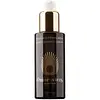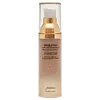What's inside
What's inside
 Key Ingredients
Key Ingredients

 Benefits
Benefits

 Concerns
Concerns

 Ingredients Side-by-side
Ingredients Side-by-side

Water
Skin ConditioningGlycerin
HumectantSaccharomyces/Grape Ferment Extract
Skin ConditioningPhenoxyethanol
PreservativeSodium Hyaluronate
HumectantPullulan
Carbomer
Emulsion StabilisingCI 77891
Cosmetic ColorantPhospholipids
Skin ConditioningBenzyl Alcohol
PerfumingMica
Cosmetic ColorantSodium Hydroxide
BufferingDisodium EDTA
Ethylhexylglycerin
Skin ConditioningColloidal Gold
AntimicrobialCI 77480
Cosmetic ColorantParfum
MaskingSilica
AbrasiveDehydroacetic Acid
PreservativePalmitoyl Tripeptide-5
Skin ConditioningLeuconostoc/Radish Root Ferment Filtrate
AntimicrobialRosa Damascena Flower Water
MaskingCI 77491
Cosmetic ColorantCaprooyl Tetrapeptide-3
Skin ProtectingDextran
Benzyl Benzoate
AntimicrobialCitronellol
PerfumingLinalool
PerfumingLimonene
PerfumingEugenol
PerfumingGeraniol
PerfumingWater, Glycerin, Saccharomyces/Grape Ferment Extract, Phenoxyethanol, Sodium Hyaluronate, Pullulan, Carbomer, CI 77891, Phospholipids, Benzyl Alcohol, Mica, Sodium Hydroxide, Disodium EDTA, Ethylhexylglycerin, Colloidal Gold, CI 77480, Parfum, Silica, Dehydroacetic Acid, Palmitoyl Tripeptide-5, Leuconostoc/Radish Root Ferment Filtrate, Rosa Damascena Flower Water, CI 77491, Caprooyl Tetrapeptide-3, Dextran, Benzyl Benzoate, Citronellol, Linalool, Limonene, Eugenol, Geraniol
Water
Skin ConditioningCaprylic/Capric Triglyceride
MaskingGlycerin
HumectantHexyl Laurate
EmollientPentylene Glycol
Skin ConditioningSodium Hyaluronate
HumectantAcetyl Tetrapeptide-2
Skin ConditioningSimmondsia Chinensis Seed Oil
EmollientTamarindus Indica Seed Gum
Emulsion StabilisingAlcaligenes Polysaccharides
EmollientSynthetic Fluorphlogopite
Mica
Cosmetic ColorantCastor Oil/Ipdi Copolymer
Caprylyl Glycol
EmollientAmodimethicone
Carbomer
Emulsion StabilisingTrisodium Ethylenediamine Disuccinate
Calcium Sodium Borosilicate
Benzyl Alcohol
PerfumingGlucose
HumectantSodium Hydroxide
BufferingSilica
AbrasiveTin Oxide
AbrasiveIron Oxides
CI 77891
Cosmetic ColorantWater, Caprylic/Capric Triglyceride, Glycerin, Hexyl Laurate, Pentylene Glycol, Sodium Hyaluronate, Acetyl Tetrapeptide-2, Simmondsia Chinensis Seed Oil, Tamarindus Indica Seed Gum, Alcaligenes Polysaccharides, Synthetic Fluorphlogopite, Mica, Castor Oil/Ipdi Copolymer, Caprylyl Glycol, Amodimethicone, Carbomer, Trisodium Ethylenediamine Disuccinate, Calcium Sodium Borosilicate, Benzyl Alcohol, Glucose, Sodium Hydroxide, Silica, Tin Oxide, Iron Oxides, CI 77891
Ingredients Explained
These ingredients are found in both products.
Ingredients higher up in an ingredient list are typically present in a larger amount.
Benzyl Alcohol is most commonly used as a preservative. It also has a subtle, sweet smell. Small amounts of Benzyl Alcohol is not irritating and safe to use in skincare products. Most Benzyl Alcohol is derived from fruits such as apricots.
Benzyl Alcohol has both antibacterial and antioxidant properties. These properties help lengthen the shelf life of products. Benzyl Alcohol is a solvent and helps dissolve other ingredients. It can also improve the texture and spreadability.
Alcohol comes in many different forms. Different types of alcohol will have different effects on skin. This ingredient is an astringent alcohol.
Using high concentrations of these alcohols are drying on the skin. They may strip away your skin's natural oils and even damage your skin barrier. Astringent alcohols may also irritate skin.
Other types of astringent alcohols include:
According to the National Rosacea Society based in the US, you should be mindful of products with these alcohols in the top half of ingredients.
Any type of sanitizing product will have high amounts of alcohol to help kill bacteria and viruses.
Learn more about Benzyl AlcoholCarbomer is a polymer of acrylic acid. Its main role is to create a gel consistency.
A high amount of carbomer can cause pilling or balling up of products. Don't worry, most products contain 1% or less of carbomer.
Ci 77891 is a white pigment from Titanium dioxide. It is naturally found in minerals such as rutile and ilmenite.
It's main function is to add a white color to cosmetics. It can also be mixed with other colors to create different shades.
Ci 77891 is commonly found in sunscreens due to its ability to block UV rays.
Learn more about CI 77891Glycerin is already naturally found in your skin. It helps moisturize and protect your skin.
A study from 2016 found glycerin to be more effective as a humectant than AHAs and hyaluronic acid.
As a humectant, it helps the skin stay hydrated by pulling moisture to your skin. The low molecular weight of glycerin allows it to pull moisture into the deeper layers of your skin.
Hydrated skin improves your skin barrier; Your skin barrier helps protect against irritants and bacteria.
Glycerin has also been found to have antimicrobial and antiviral properties. Due to these properties, glycerin is often used in wound and burn treatments.
In cosmetics, glycerin is usually derived from plants such as soybean or palm. However, it can also be sourced from animals, such as tallow or animal fat.
This ingredient is organic, colorless, odorless, and non-toxic.
Glycerin is the name for this ingredient in American English. British English uses Glycerol/Glycerine.
Learn more about GlycerinMica is a naturally occurring mineral used to add shimmer and color in cosmetics. It can also help improve the texture of a product or give it an opaque, white/silver color.
Serecite is the name for very fine but ragged grains of mica.
This ingredient is often coated with metal oxides like titanium dioxide. Trace amounts of heavy metals may be found in mica, but these metals are not harmful in our personal products.
Mica has been used since prehistoric times throughout the world. Ancient Egyptian, Indian, Greek, Roman, Aztec, and Chinese civilizations have used mica.
Learn more about MicaSilica, also known as silicon dioxide, is a naturally occurring mineral. It is used as a fine, spherical, and porous powder in cosmetics.
Though it has exfoliant properties, the function of silica varies depending on the product.
The unique structure of silica enhances the spreadability and adds smoothness, making it a great texture enhancer.
It is also used as an active carrier, emulsifier, and mattifier due to its ability to absorb excess oil.
In some products, tiny microneedles called spicules are made from silica or hydrolyzed sponge. When you rub them in, they lightly polish away dead skin layers and enhance the penetration of active ingredients.
Learn more about SilicaSodium Hyaluronate is hyaluronic acid's salt form. It is commonly derived from the sodium salt of hyaluronic acid.
Like hyaluronic acid, it is great at holding water and acts as a humectant. This makes it a great skin hydrating ingredient.
Sodium Hyaluronate is naturally occurring in our bodies and is mostly found in eye fluid and joints.
These are some other common types of Hyaluronic Acid:
Learn more about Sodium HyaluronateSodium Hydroxide is also known as lye or caustic soda. It is used to adjust the pH of products; many ingredients require a specific pH to be effective.
In small amounts, sodium hydroxide is considered safe to use. However, large amounts may cause chemical burns due to its high alkaline.
Your skin has a natural pH and acid mantle. This acid mantle helps prevent harmful bacteria from breaking through. The acid mantle also helps keep your skin hydrated.
"Alkaline" refers to a high pH level. A low pH level would be considered acidic.
Learn more about Sodium HydroxideWater. It's the most common cosmetic ingredient of all. You'll usually see it at the top of ingredient lists, meaning that it makes up the largest part of the product.
So why is it so popular? Water most often acts as a solvent - this means that it helps dissolve other ingredients into the formulation.
You'll also recognize water as that liquid we all need to stay alive. If you see this, drink a glass of water. Stay hydrated!
Learn more about Water